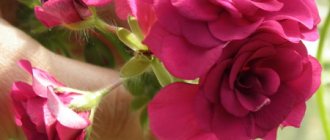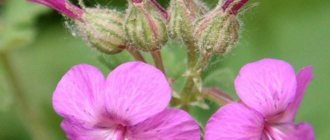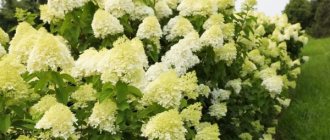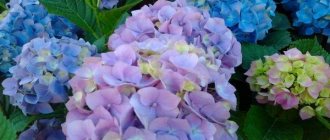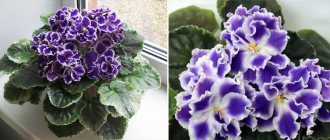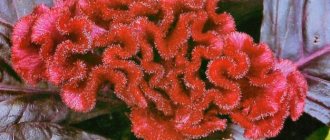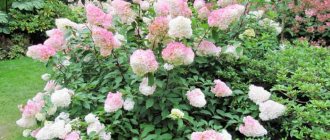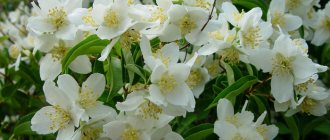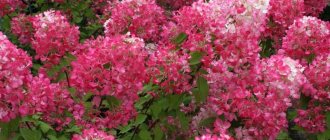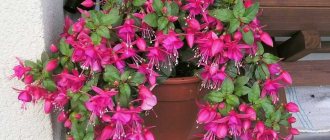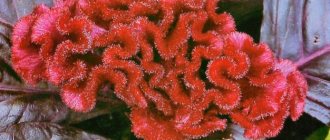Botanical description and history
Ivy geranium belongs to the geranium family, genus - geranium (Geranium) . Its homeland is the southern regions of Africa, where in nature the plant lives on high hills and cascades down the slopes. Therefore, the flower tolerates temporary lack of moisture well and is a heat-loving and light-loving plant.
Geranium ivy or ivy-leaved is an ampelous plant, a subshrub, capable of growing up to 1 m in height. Due to the fact that the shape of the leaves is similar to ivy (five-lobed, fleshy, whole), the plant got its name. The leaf width is from 3 to 6 cm. The color is green, sometimes with veins or a white border.
Star-shaped flowers of various colors and shades . Collected in umbrella inflorescences, the diameter of which can be 8 cm. Large inflorescences can consist of 30 flowers. The average flower size is 1.5-2.5 cm, but more impressive specimens can reach 4 cm.
Pelargonium varieties
Among the older varieties:
- pink pelargonium Pani Crousse,
- variety of pink carmine Queen of Balconies,
- white pelargonium Joan d'arc,
- variety of cyclamen righi,
- scarlet marquise and
- purple variety Alice Crousse.
Today, prized varieties include, among others, the purple hanging geranium Amethyst, the carmine-red variety El Gaucho, the dark purple hanging geranium Santa Paula, the salmon-pink ville de paris and the carmine-pink ampelous geraniums.
Hybrid varieties will also grow well on the balcony and terrace, for example, the dark red drooping Marquise, which blooms earlier than the classic ivy-leaved geranium and grows better. This is a self-cleaning variety (faded inflorescences do not need to be removed). Very resistant to adverse weather conditions. The ivy-leaved pelargonium of the apricot variety with pink flowers looks especially beautiful. In turn, the hanging one is a burgundy-white variety of huge burgundy-colored fireballs.
There are geraniums with two-color leaves - varieties from the Argentum group, as well as euca and elegante. Noteworthy are the red ampelous pelargonium ville de paris, purple Amethyst, pink hanging roi des balcons, pale pink magic. And new varieties: apricot royal, peach and dark pink Sybil Holmes. Semi-double geraniums are very good, which are distinguished by large, semi-double flowers of white and pink.
Appearance
Ivy geranium flowers come in a wide variety of colors and shades: white, scarlet, red, lilac, pink. In appearance, the inflorescence resembles a peony. The leaves are smooth to the touch, the branches are 70-90 cm long. This plant differs from other types of geranium in its drooping stems and stiffer leaves.
The plant is climbing, easily propagated and blooms for a long time: from spring to late autumn. The inflorescences are voluminous, round in shape. In addition to the beautiful appearance of the flowers, ivy-leaved geranium is also distinguished by its incredible endurance.
Application in landscape design
Ivy-leaved pelargonium deserves a special place in garden and indoor landscaping. Its hardiness, low watering requirements and ability to withstand direct sunlight make it an ideal plant for vertical gardening in containers and flowerpots. Strong shoots will not be broken by the wind in balcony compositions, and the ability to weave along the support allows them to be used for small trellises. It looks great indoors all year round and retains its green leaf mass in winter.
How to arrange geranium-pelargonium in the garden plot
Why do professional designers create the most beautiful gardens? The fact is that they think through the design project in advance and use various decorations for the garden. To make you proud of your suburban area at all times of the year, consider a set of plants that will bloom at different times. Decoration is also very important, let's see how you can decorate a geranium.
How to incorporate geranium into landscape design:
- Ivy geranium is distinguished by its creeping nature. This is a flower that will look great on alpine slides and gazebos. Another interesting technique is when a clay jug is placed on its side in the garden, and creeping pelargonium is planted next to it. Thus, it seems that beautiful flowers have poured out of the jug.
- Rose geranium is incredibly beautiful. It can be placed in a decorative wooden cart. It will seem that the florist is bringing his harvest for sale.
- You can plant creeping forms of plants on the balcony. In this case, the plant will entwine its frame, and from the street it will look amazing.
To create a landscape design for your garden, you can collect ideas from all over the world. In this case, you will be able to create a unique design on your site or window that will amaze everyone with its beauty.
Geranium is a plant that blooms with beautiful fragrant flowers. You can and should plant it in your suburban area, but you need to know how to do it correctly. In this case, you will get a chic landscape design.
Video tips from landscape designers
Popular varieties with photos
Next in the photo you can see some popular varieties of ivy or ivy-leaved geranium.
Over the past three centuries, breeders have managed to develop many different varieties of ivy-shaped geraniums that feel comfortable at home and outdoors.
"Amethyst"
A very popular variety of ivy geranium used to create flower baskets. This variety branches well and develops quickly , so in summer it is often planted in garden flowerpots, and in winter it is brought indoors. It blooms with large double buds of raspberry and pink shades, similar to roses.
"Dacora Pink"
A plant with large light green leaves is beautiful even when it is not blooming. The flowers are simple, neon pink, consisting of five petals with several veins of red or crimson.
"Marble Sunset"
A compact plant with decorative leaves covered with cream or light green spots. In the sun, the leaves take on a golden or bronze hue . Purple veins are clearly visible on the petals.
The variety is very capricious, so it is not popular in home gardening.
"Ise Rose"
This plant resembles a bush rose . The buds are white with a slight greenish tint. Blooms thickly and for a long time. In bright sun, the flowers may take on a lilac hue.
"Rouletta"
This variety of ivy-shaped geranium is used for planting in large flower pots, both indoors and in gardens. Small bush with short internodes. The stems branch weakly and bloom profusely with simple white flowers with small pink specks and a crimson border on the petals.
"Tornado Fuchsia"
A lush variety of climbing geranium with rich green foliage. The shape of the flower resembles the wings of a butterfly . The flowers are lilac-colored with spots and veins. This variety creates beautiful compositions for the street; the plant grows quickly, and with proper care it blooms for a long time.
How a flower propagates: by seeds
This method is the longest and most labor-intensive, so in practice it is rarely used. In addition, when grown from seeds, varietal qualities deteriorate. Planting seeds is done in the spring. Planting material is purchased in advance at the store. A drainage layer of expanded clay is formed in the growing pots. Soil is poured into the container on top and watered.
Before planting, the seeds are soaked for 24 hours in a solution of a growth stimulator. After this, they are laid on the ground and lightly sprinkled with earth. The soil is sprayed from above and covered with film, putting it in a lighted place with a temperature of about 24 degrees. After eight to ten days, the first seedlings appear. After the third leaf, the seedlings are transplanted into separate pots.
Cuttings
This method of reproduction is considered effective. In spring, it is necessary to prepare layering. They are cut from the bush. Each cutting must be at least seven centimeters long and have at least two nodes. Layers are not placed in water, as the plant may rot. They are immediately rooted into the ground. The cut should be lubricated with a stimulator for the growth of the root system.
You need to make drainage in the planting container, fill it with soil and water it. Layers are buried in the ground so that the first node is above the substrate level. The cuttings are covered with a cut plastic bottle, and the container is placed in a bright, warm place. After three weeks, the cuttings begin to form roots. The first leaves appear on the shoots and are pinched off. Usually, if the procedure is carried out in spring, the plant begins to bloom in the first season.
Where and how to plant it: rules and tips, instructions
Hanging flowerpots, baskets, and boxes on balconies are most suitable for planting geraniums. This light-loving plant should be placed on the sunny side. It also looks beautiful and harmonious on the facades of houses. And if you plant this type of geranium on a flat area, the plant will create a dense flowering carpet.
Prepare seedlings in spring or early autumn. To decorate the balcony, rooted plants are planted in boxes in one row, at a distance of 15 cm from each other.
Young plants must be regularly watered and fed with mineral fertilizer, which is applied in small portions.
Lighting and location
Ivy geranium prefers the sunny side, so it is better to place a flowerpot with a plant on a south-east or south-west window in the room. It feels great outdoors and even on hot summer days the plant does not wither and continues to bloom. But if geranium grows in partial shade, then you may not see its abundant flowering.
Soil requirements
Ampelous geranium is not demanding on the soil, however, for successful growth and development of the bush, the soil must be loose and well-drained . The following compositions can be used:
Universal soil for indoor plants is mixed with perlite, river sand and vermiculite in equal proportions (perlite and vermiculite can be replaced with humus and peat).- Soil from the garden, taken from under bushes or trees, is suitable.
- 8 parts turf soil, 2 parts humus, 1 part river sand.
- In equal proportions: turf, leaf soil, peat and sand.
Ivy geranium also feels comfortable in a loose nutritious substrate , to which a little clay is added.
Read more about growing ivy or ivy-leaved geraniums at home in a separate article.
Boarding and seating
DenesFeri / Personal archive
- First of all a container suitable for planting with mandatory drainage holes in the bottom. In their absence, it will be difficult for the plant to cope with excess water , especially after heavy rains.
- The presence of a drainage layer in the pots will also help remove excess moisture from the roots of the plant.
- of the soil is very important . specialized for pelargoniums or universal for flowering species) is best Prepared on your own will also not fail if it is loose and nutritious , well permeable to air and moisture.
- The place to place ampelous pelargonium will need a bright sunny place with light shading from midday rays, protected from drafts and strong winds. If these are windows , then southern or western ones are preferable. Lack of light negatively affects flowering.
pxhere.com 1119910 / Personal archive
How to properly care?
In order for ivy-leaved geranium to feel comfortable, it needs to create favorable conditions:
- Water the flower in hot weather often, but in small portions. In winter, watering should be reduced to 2-3 times a month and ensure that water does not get on the leaves.
- In spring and summer, feed with phosphorus and potassium fertilizers three times a month. Magnesium sulfate will also be useful for climbing geraniums - it promotes long-term flowering, but nitrogen fertilizers reduce the flowering of the plant.
- At the end of February, geraniums are pruned and shoots are pinched - this will promote tillering and more abundant flowering.
- The plant is replanted once every two years in the spring; the pot should not be too large.
Good to know! Ivy-leaved geranium tolerates replanting well at any age.
You can learn more about caring for ivy-leaved geraniums here.
Caring for ivy-leaved pelargonium at home
Ampelous pelargonium is not too demanding to care for. Such plants adapt quite easily to apartment conditions and do not require complex care either at home or outside.
Lighting
Ampelous pelargonium, being a native of Africa, needs bright lighting. It is not afraid of burns and can grow on windows facing south or southwest. Only in extreme heat can the bushes be slightly shaded. In less lit areas, plants will not bloom as profusely. In winter, even if the bushes are moved to a cool place, they try not to change the lighting mode. Lack of light will lead to elongated shoots, too pale leaves and their falling off.
Temperature
Geranium develops best at a temperature of 20-25 degrees. In the heat, delicate flowers wither too quickly, losing moisture. In winter, the bushes are moved to a cool, but always bright place. The exact permissible temperature thresholds depend on the variety, but on average range from 10 to 15 degrees. Many varieties can tolerate short-term cold snaps down to zero. If you can’t keep pelargonium in a cool place, you can at least protect it from proximity to heating devices. To do this, move the plant to another place, or try to increase the air humidity and ventilate the room more often.
Watering
Ampelous geranium tolerates short drought much better than waterlogging. Stagnation of moisture at the roots can provoke various diseases and lead to their rotting. This can be avoided by providing the flower with a good drainage layer in advance. Its thickness should be at least a centimeter. Thanks to this layer, the roots will be protected from contact with excess moisture - it will be removed through the drainage holes, which will also help to ventilate the soil in the pot.
To avoid excessive moisture, watering is carried out regularly and moderately - the soil in the pot should have time to dry out between them. In winter, watering is reduced, but their frequency will depend on the temperature in the room. This species does not need spraying or bathing. You can irrigate its leaves only as part of medical procedures.
Choosing a pot
To grow pelargonium ivy, use a pot that is only slightly (1-2 cm) larger than the previous one in size. Excessive volume will delay flowering time and may adversely affect root health due to slower soil drying. Correctly selected material will help to avoid many diseases. In unglazed ceramic pots, the flow of oxygen to the roots will be greater than in plastic containers. In addition, there must be drainage holes at the bottom to protect against stagnation of water. An additional layer of drainage up to 2 cm thick is poured onto the bottom. For this, you can use expanded clay, brick fragments, etc.
The soil
Ivy geranium develops best in neutral, moderately fertile soil. For young bushes, baking powder is additionally added to the substrate - perlite, vermiculite, etc. You can also use purchased soil for flowers. If you prepare the soil yourself, a mixture of peat with sand and two parts of turf soil is suitable. For an adult plant, you can also add coal and a little clay to the substrate.
Before planting a bush, any soil must be disinfected by pouring boiling water or a solution of potassium permanganate on it, or by calcining it in the oven.
Feeding
Geranium is fed only in the warm season - in winter the plant rests. The growing season of the bush starts around the end of February. From this period you can begin to fertilize the plant with mineral compounds. It is recommended to use a weaker concentration of nutrient solution than indicated on the package. Feeding is carried out once every 1-2 weeks. The first 2-3 times after emerging from hibernation, the bushes are fertilized with nitrogen to activate the development of fresh growth. Starting in April, you can switch to formulations for flowering plants, which are dominated by potassium and phosphorus. In winter, geraniums are fertilized no more than once a month or not fed at all.
Transfer
Transplantation of ivy-leaved pelargonium is carried out according to general principles. When replanting a large geranium bush, you can divide it at the same time. The need for this procedure can be judged by the size of the bush. If the pelargonium roots have already completely filled the pot and are visible through the drainage holes, the plant needs a more spacious container. The procedure is best carried out in early spring. It stimulates the active development of the bush after winter rest, and nitrogen supplements introduced during this period will help it grow faster. If necessary, replanting can be carried out in the fall, combining it with seasonal pruning. The main thing is not to disturb the plant during periods of rest or flowering - this will lead to the dropping of buds and slower growth of the bush. Sometimes such geraniums bloom again only the next year.
Trimming
To get a beautifully shaped bush, pruning of ivy-leaved pelargonium is carried out twice a year. In autumn, all old and bare stems are cut off by 1-2 thirds. The cuts are made at an angle using a tool with a clean and sharp blade. For disinfection, it is recommended to treat them with crushed coal.
At the beginning of spring, stems that are too elongated must be pinched. Each shoot must have at least 5 internodes. If you prune the bush more strongly in the spring, you can damage the flower buds. This will shift the timing of flowering or lead to its absence.
Wintering
Ideally, ivy-leaved pelargonium should spend the winter in a cool and bright room, where it stays at just over 10 degrees, but not higher than 15 degrees. In this case, the number of waterings is reduced, carried out only once every 10-15 days. You should not feed a resting plant. In such conditions, the bush will be able to lay more flower buds, which will provide it with high decorative value next season.
Bloom
In order for ampelous geranium to bloom magnificently, the plant will require certain conditions - abundant lighting and regular feeding. In spring, the flower is fed 2-3 times with compounds containing a lot of nitrogen, but then the amount of this element is reduced. Otherwise, the bush will begin to actively develop foliage, but will hardly form buds. All further fertilizing should contain more potassium and phosphorus, necessary for flowering.
Pruning is also important for flower formation. The main one is carried out in the fall, deeply pruning old bare shoots. In spring, the stems are only lightly pinched so as not to interfere with the formation of flower stalks.
In addition, geranium, like many other flower crops, will only be able to form buds in a slightly cramped container. When replanting, the new pot may exceed the old one in size by only a couple of centimeters, otherwise it will be more difficult for the bush to cover a large volume of soil.
Common diseases and pests
The plant may be attacked by pests:
- Thrips - appear in the form of growths on the back of the leaf, which leads to their deformation and the appearance of spots on the flowers.
- Mites often infest the edges and appear as yellow speckles on the leaves and can cause them to wilt. The appearance of ticks is provoked by heat and dry air.
- If curled, yellowed leaves appear on the plant, it means that aphids have settled on it.
The most dangerous disease of ivy geranium is blackleg. This disease is very difficult to fight, therefore, it is better to destroy such a plant so that the disease does not spread to other flowers.
Why doesn't it bloom?
When buying ivy-leaved pelargonium in a store, they are often assured that it blooms profusely and pleases the eye every season. Believing the sellers' words, you bring the flower home and soon notice that the flower does not bloom, but only climbs up.
One of the reasons may be incorrect soil composition. Sandy soil is good for growing this type of plant. Pelargonium will not bloom in peat soil due to poor air permeability. If your ivy pelargonium is in peat soil, then it should be replanted. If the passage of moisture and air is poor, the root system can rot and lead to the loss of the flower.
Another reason could be improper placement of the plant. If a flower lacks abundant light and sunlight, then what kind of flowering can we even talk about? Help pelargonium “live” and give it some warmth.
Features of reproduction
Propagated by cuttings and seeds. Propagation of ivy geranium by cuttings:
- In spring, cut off the upper part of vertical shoots 7-10 cm long, preferably with four healthy leaves.
- Dry the cuttings, sprinkle the cut areas with charcoal powder and plant them in loose soil to a depth of 3-4 cm for rooting.
- The first watering should be plentiful, and all subsequent watering should be moderate.
- When the roots appear, the geranium is transplanted to a permanent place in prepared pots with soil.
Attention! For successful rooting and growing of climbing geraniums, it is necessary to maintain an ambient temperature of 20 to 22 degrees.
Geranium seeds can be sown from April to November.
- The soil for seeds should be loose and light. To do this, you can mix universal soil, peat and coarse sand.
- The seeds are deepened by half a centimeter, covered with film, periodically opening and spraying the ground with a spray bottle.
They produce excellent seedlings, but in winter additional lighting is necessary , since daylight hours must be at least 12 hours.
Unpretentious, brightly blooming ivy-shaped geraniums look incredibly beautiful in hanging flowerpots and can decorate a corner of any garden or room. In Europe, climbing geranium is used for landscaping arched structures. With proper care, this plant can bloom for six months without interruption.
Who doesn't know geranium? This beautiful and fragrant flower can often be seen in a flowerbed or loggia. But does everyone know how many species and varieties of this plant there are? We have prepared a number of separate articles from which you can learn about the white and black varieties of geranium, about rosebud, royal and tulip-shaped, about the varieties Rosanna and Angel, the amazing Peony and the beautiful Roberta.
Ampelous pelargonium - summer outdoors
If pelargonium decorates a room, it does not have to adapt to changes in humidity, light and temperature; it blooms all summer in the most comfortable conditions, which cannot be said about plants displayed in the garden or outside the window. To gradually acclimatize ivy-leaved ampelous pelargoniums, bushes planted in selected containers with the arrival of heat begin to be exposed to the street, making sure that the plants are not exposed to sub-zero temperatures and are not exposed to direct sunlight for a long time.
In May or a little later, when the time of frost has passed, pelargoniums can be sent to a permanent place, where they will spend the whole summer, until autumn, when the air temperature begins to drop to 10–15 °C. Ivy-leaved pelargoniums quickly enter the flowering season and are very attractive if bushes with contrasting flower colors bloom nearby.
Soil selection, complementary feeding and replanting
Ivy-leaved ampelous geranium is unpretentious to the soil. The only condition is its fertility.
Advice. Geranium takes root and grows best in soil of 5 components: peat, leaf, turf and humus soil, sand. All this should be used in equal quantities.
This plant does not need a large and spacious pot. On the contrary, a small or even cramped pot or flowerpot is the best place to grow geraniums. The optimal size is that the roots are located 1-1.5 cm from the walls of the pot.
Geraniums are fed only in spring and summer. This is done once every ten days using potassium fertilizer. There is no need to do this in autumn and winter.
The ampelous geranium must be replanted, as it grows and the pots become too cramped for it, and the soil becomes depleted. This happens once every 2 years. The best time to transplant is spring. Even if the plant has not grown, you need to at least update the soil - add peat soil.
Young plants
Beautiful cascades of amazing flowers
Proper implementation of planting and caring for pelargonium will be the key to obtaining a healthy, profusely flowering plant that will delight you throughout the season with beautiful cascades of delightful flowers. Not only members of the household, but also neighbors, guests, and random passers-by will be able to admire them.
An ampelous representative of the Geraniev family immigrated to us at the beginning of the 18th century from the south of the African continent.
Over the past decades, domestic breeders have managed to develop various varieties that are maximally adapted to our climatic conditions.
Today, ampelous ivy-leaved pelargonium is a common indoor flower that delights with beautiful inflorescences and a pleasant aroma.
Differences from ordinary geranium
Very often, ivy-leaved pelargonium is mistakenly called geranium ; on many sites you will find the use of these two names as synonyms. Initially, confusion arose due to incorrect attempts by scientists to classify the plant back in the 17th century. To fully appreciate the differences between two different flowers, it is worth considering the signs that indicate this:
Geranium ivy is a low plant with an erect base. Pelargonium is a decorative creeping subshrub, the shoots of which grow up to a meter in length.- Ivy geranium leaves are delicate and soft to the touch, while pelargonium leaves are characterized by glossy surfaces and five-lobed shapes.
- The bright red inflorescences of indoor plants are very decorative, which is why they have won the sympathy of gardeners. Common geraniums have symmetrical blue flowers.
- Being native to the southern hemisphere, many varieties of pelargonium are heat-loving and suitable for growing exclusively indoors. And geraniums can also be planted in gardens, because... its homeland is northern latitudes and it can withstand cold temperatures
Spectacular hanging plant
Ivy-leaved pelargonium is a very spectacular hanging plant with abundant and very long flowering. It has not yet become widespread in home and garden floriculture, as it is mistakenly considered a very fastidious herbaceous perennial. Ampelous pelargonium is, in fact, extremely unpretentious and requires minimal care, which we will talk about a little later.
Long stems of pelargonium creep along the ground or hang from a hanging pot. The shoots reach 80-90 cm in length, curl a little and can intertwine with each other. The surface of the stems is smooth and elastic. The stems are not brittle and are capable of forming several lateral shoots, which helps the plant form a dense bush. The leaf blades are smooth and cool to the touch. The smooth surface is slightly glossy and reaches a maximum width of 5-6 cm. Due to the similarity of the leaf with ivy, the variety is called ivy-leaved. There are varieties with beautiful decorative leaves.
The flowering of the variety is long and continuous. At this time, large flowers are formed, collected in spherical inflorescences - apical umbrellas. There are varieties with double buds similar to tulips or roses. Perennials can have semi-double or single flower petals that form a bud similar to a carnation. Almost always, umbrellas are brightly colored. It can even be two-color.

